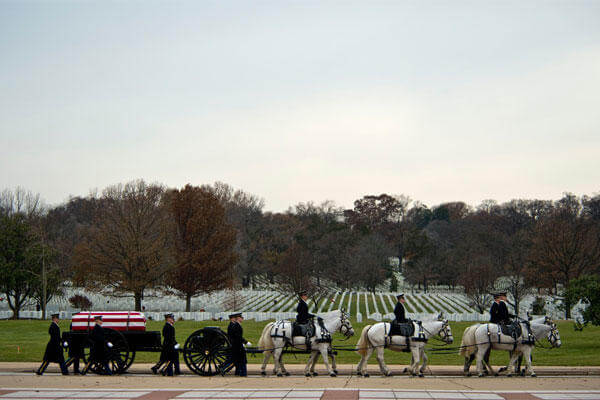ARLINGTON, Va. -- The remains of an Army Air Force Airman who had been missing since World War II was buried with full honors at Arlington National Cemetery on Dec. 4.
Sgt. Charles A. Gardner’s remains were found in 2001 by a U.S.-led team that found wreckage with a tail number that matched his B-24D Liberator. Gardner and 11 other crew members were missing after they were shot down over Madang Province on a planned attack on an anti-aircraft site at Hansa Bay on the north coast of Papua, New Guinea, on April 10, 1944. The bay was a major Japanese naval base and transit station during World War II.
Theodore Gardner was only a teenager when the family was notified that his older brother was missing in 1944, so most of his memories were of letters sent home during the war. However, he has a vivid memory of his father’s reaction upon receiving the telegram with the terrible news.
“We were sitting at our kitchen table where we lived in Mullins, South Carolina,” Gardner said. “My father laid his head on the table and cried. That was one of the very few times I ever saw my father cry, and it was the first emotional part of my brother’s death to us.”
Gardner was the one who received the phone call about six months ago informing him that his brother’s remains were identified and asking where the family wanted him to be buried. Since there really weren’t any family members and friends left on the West Coast where the older brother grew up, Gardner didn’t hesitate to say Arlington National Cemetery was where he should be finally laid to rest.
Four of Gardner’s fellow crew members died in captivity after they parachuted from the B-24D safely after it was hit. However, the Army Graves Registration Service only recovered remains of three others after the war, so Gardner remained missing for almost six decades. According to Department of Defense information, scientists from the Joint POW/MIA Accounting Command and the Armed Forces DNA Identification Laboratory identified Gardner’s remains.
Harvey March Jr., Gardner’s nephew, was expecting an emotional day before his uncle’s service at Arlington.
“I know it’s going to be an emotional day,” March said.” “I’m emotional already.”
It was March’s DNA, and that of his cousin, the late Elaine Steinmetz, that enabled their uncle’s remains to be eventually identified. Steinmetz died in March.
“I thought it was amazing,” March said about the DNA. “Glory be that we have it.”
Because Gardner was an Army Air Force Airman, the 3rd U.S. Infantry Regiment, also known as “The Old Guard,” conducted military honors for his service, which included a caisson, escort platoon, colors and caskets team, firing party and the U.S. Army Band (“Pershing’s Own.”) Before Gardner received his brother’s flag and the three-rifle salute, Army Chaplain (Capt.) Ted Randall summed up the family’s feelings.
“For our comrade, Sgt. Charles Gardner, our nation bestows military honors,” the chaplain said at the end of his remarks. “In life, he honored the flag, and in death, the flag will honor him.”
The day was an emotional one for Gardner’s family, but it also was one that finally brought some closure after a six-decade effort to bring him to his final resting place at Arlington.
“I expect it will be emotional for us to a certain point,” Gardner said. “But the fact is we will know this is finally taken care of, that we were able to bring Charles to his final resting place.”
























